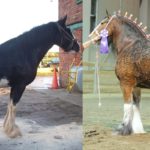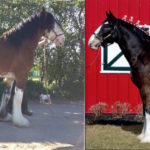One of the most common questions we get asked is, “What’s the difference between a Shire and a Clydesdale?”
You’re likely to get many different answers to this question, depending on who you ask. But here’s what we think…
The two breeds have a shared history that goes back centuries. They were only formally distinguished from one another about a century and a half ago. In the last hundred years, they’ve been classified separately, but prior to that the history books don’t talk about two separate breeds, but a type of heavy set horse used for work.
William the Conqueror brought Great Horses to Britain in 1066. Stallions around 150cm high at the shoulder (more like small Percherons than the Shires or Clydesdales we see today) were ridden at a slow trot towards the enemy. As the need to carry knights into battle disappeared, the Great Horse evolved into a working animal. Speed was no longer a factor – size and strength are what matters for a draught horse being worked.
In 17th century England, the Black Horse (a strong, dark coloured work horse) became common, partially as a result of imports from the Netherlands. Breeders worked to maintain the size and strength of the horses while improving its qualities.
In 1755, the famous ‘Packington Blind Horse’, a black horse who became the foundation stallion for Shire horses, appeared. He stood at stud at Packington, near Ashby de la Zouch, until 1770. He appears in the first Shire studbook due to the large number of horses descended from him. By 1800, the Shire was a recognisable draught breed with a consistent type despite the lack of a studbook, which would come later. This is the time that the documented history of the Shire Horse began.
While the English were developing large, heavy set horses with solid colouring, the Scottish were placing particular emphasis on the limbs, feet and silky feather. In Scotland, little import was given to colour.
The Shire horse remained popular in Great Britain, but in the 20th century Clydesdales had a huge surge in worldwide popularity. By the mid 1940’s tens of thousands of Clydesdales had been exported to America, Australia & New Zealand.
Sadly, by the 1960’s heavy horse numbers had dropped dramatically. The gentle giants, renowned for their strength and temperament, had almost died out due to the rise of mechanised agriculture following the Industrial Revolution.
They survived as a result of the dedication of a small group of breeders and the commitment of English breweries, who have continued to use Shires as promotional ‘mascots’ pulling traditional brewery vehicles.
In Scotland, the term Clydesdale was first used at an agricultural exhibition in 1826. At the time, ‘Glancer/Thompson’s Black Horse’ was the most influential stallion. He was described as short and powerful with strong legs, clear bones, silky feather and white hind legs. His bloodline could be traced back to a Flemish stallion.
From the 18th century onwards, transport and trade played a critical role in economics and would not have been possible without heavy horses. The 19th century brought with it an increase in the demand for heavy working horses to pull public transport vehicles like busses and trams.
In the 1850’s and 60’s, high quality English mares were sent to Scotland by the hundreds. There, they formed the basis of the new Clydesdale breed. In 1877, the Clydesdale Horse Society was founded in Scotland, followed the next year by the Shire Horse Society in England. Thus the official distinction between the two breeds formed and two different types began to develop from fundamentally similar horses.
When the two breeds formally separated about 160 years ago, breeders didn’t give a lot of thought to their similarity. Still, it’s clear that the Shire and Clydesdale have greatly influenced one another throughout history, and they continue to do so.
Though there are a few criteria that can be used to separate the modern Shire and Clydesdale, there are always horses from both breeds that even an expert would be hard pressed to name as one or the other without prior knowledge.
Perhaps the most obvious difference between the two breeds in the modern era is colouring. The Shire is solid coloured with white markings on the legs and face that vary. The Clydesdale often has very distinctive white markings all over the body and more white hair spread through the coat.
A striking angle in the hock and narrow set of the hind legs, with parallel cannon bones, is desirable in both breeds but often more apparent in the Clydesdale. High hocks are also seen in both breeds, but again the Clydesdales tend to display this trait more conspicuously. Clydesdales tend to have a longer cannon bone and finer feather, though it is important to note that this does not mean less feather.
Shires frequently have a higher head carriage, a shorter back and a more impressive top line. The tail set of a Shire is generally higher than that of a Clydesdale, contributing to a better croup angle. Shires are also generally broader in the chest and taller than Clydesdales.
To make matters even more complicated, there’s also a variance of types in both breeds depending on the country you’re in. While the ‘ideal’ conformation is the same according to the breed standards, breeders worldwide tend toward the characteristics their market demands. For example, in America you’re likely to find that both Shires and Clydesdales have a longer leg and higher action due to the demand created by the hitch market there. In Australian Clydesdales there is a tendency for breeders to look for the full package created by a sound working type, where in Scotland you see a particular emphasis on the legs and feet. The difference between the English and Australian Shire is less marked, though some would argue the major distinction is the gap in quality created by the smaller number of Shires in Australia. The English Shire is also generally taller than its Australian counterpart.
If you’re keen to test your eye, we’ve created a gallery of images below, each with a Shire and a Clydesdale. The answers are listed in small text at the bottom of the about us page. Give it a try and see how you do!
- Image 1
- Image 2
- Image 3



